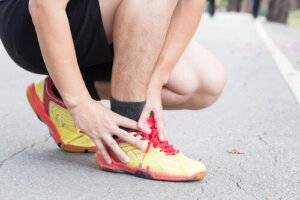How Long Does Tendinitis Take to Heal?


Written and verified by the doctor Leonardo Biolatto
It can take a considerable time to cure tendinitis. This disease is an inflammation of the tendon that causes swelling and pain, so it needs a recovery process that may require rehabilitation. The symptoms it causes are usually very annoying and affect a person’s quality of life. The worst thing is that, in some cases, it can even become chronic and repetitive.
It’s estimated that between 60 and 70% of people have experienced tendinitis at some time in their lives. The main cause is overuse of the tendons, so athletes and sportsmen are the most exposed. Although it affects any tendon, it’s most common in the shoulders, elbows, wrists, knees, and heels.
The symptoms of tendonitis
Tendons are fibrous structures that link muscle to bone. Their main function is to bind, contribute to movement, and provide flexibility. Tendonitis is an acute inflammatory process that causes structural changes in the tendon.
The main symptom of tendonitis is pain that tends to worsen with movement. However, the characteristics of the pain will depend on the region affected. In addition, individuals may report any of the following clinical manifestations:
- Difficulty in performing certain movements
- Joint crunching
- Swelling of the affected area, sometimes with heat and redness
- Bulging of the tendon
The causes of tendonitis
Tendonitis arises from muscle overload or injury. However, age has an influence, as tendons lose elasticity as we get older and sometimes degenerate. There are also some pathologies that cause this type of inflammation, such as arthritis and diabetes.
In many cases, this problem is due to sports practices or physical activities performed inadequately. If certain muscles are strengthened more than others, this leads to a weakening of the tendons. Jobs that require repetitive movements also increase the risk of inflammation.

We think you may also enjoy reading this article: How to Relieve Tendinitis with Very Effective Natural Solutions
The most common types of tendonitis
This condition doesn’t always present itself in the same way. Similarly, each site of presentation has characteristics that make it specific with particular signs and symptoms. The most frequent types of tendinitis are the following:
- Heel: This particularly affects the Achilles tendon, which connects the back of the leg to the calcaneal bone. Anyone can suffer from it, and it causes severe pain when standing on tiptoe or walking.
- Hand: Its main characteristic is the intense pain that arises when opening and closing the hand. It’s typical of those who carry out certain upper limb activities, such as climbing.
- Wrist: This is experienced as pain in the hands or wrists, usually radiating to the forearm. Nowadays, it appears very frequently due to the continuous use of keyboards and mice.
- Elbow: This appears in those who have to exert a lot of force with their arms, such as tennis players. It manifests as intense pain in the anterior or area just behind the elbow.
- Shoulder: This leads to pain when moving the arms. It’s very common in people over 40 years of age and in those who do a lot of exercise that compromises this area.
Like this article? You may also like to read: Wrist Tendonitis: Symptoms, Causes, and Treatments
General measures to cure tendinitis
Although the specific treatment will depend on each particular case, there are certain general measures that everyone can apply to cure tendinitis quickly. The recommendations should be followed for at least three days to control the symptoms and are as follows:
- Rest: This is the most important measure. The key is to avoid doing the activities that generated the injury and reduce the movement of the affected muscle.
- Cold treatment: Placing ice on the affected area for 20 minutes every three hours will help reduce inflammation. Remember to place a cloth between the ice and the skin to prevent cold burns.
- Compression: Another recommendation to cure tendinitis is to compress the region. A compressive bandage would be ideal as it helps to reduce the movement of the area.
- Elevation: The affected limb should be kept elevated when lying down to reduce both inflammation and pain.
How long does tendinitis take to heal?
It’s not possible to say exactly how long it takes for tendinitis to heal. This depends on the affected area, the severity of this anomaly, and the care applied to overcome it. In no case does it recovers spontaneously.
Mild tendinitis is usually overcome within two to three days, following medical advice. The most common recommendation is to keep the affected area still and apply ice for 20 minutes every three hours. Sometimes analgesics are prescribed if the pain is difficult to bear, as well as the elevation of the affected limb when lying down.
When to go to the doctor?
In case of very intense pain and inflammation or if the condition hasn’t gotten better three days after treatment or there’s the presence of cracking in the joint, it’s important to go to the doctor. It’s possible that certain injections called infiltrations are required or that some complication has arisen that leads to evaluating the surgical option.
Very severe cases of tendinitis could take several weeks, and even months, to heal. A determining factor is the care that’s applied. Resting the affected area is essential, but it’s also advisable to make gentle movements so that the tendon doesn’t become too stiff.
Physiotherapy is one of the techniques used in the rehabilitation of tendinitis
How to prevent tendinitis
As we’ve already mentioned, tendinitis is caused by repetitive movements at work or by high-intensity exercises. Fortunately, there are some recommendations that can be followed to avoid the appearance of this problem, among which are the following:
- Warm up the muscles well before exercising.
- Stretch frequently.
- Wear comfortable shoes when exercising.
- Take breaks when exercising.
- Constantly change position when working.
- Place the keyboard and computer screen in a comfortable position.
- Adopt a proper posture when sitting.
- Exercise with proper technique.
Healing tendinitis is a long task
It’s very important to heal tendinitis completely, since failure to do so may lead to long-term problems. If the inflammation persists for a long time, there’s a risk of new injuries, and even a rupture of the tendon may occur.
After recovery, it will be necessary to take the necessary measures to prevent the tendon from becoming inflamed again. Among the most common recommendations are to warm up before any sporting activity and exercise all muscles to increase strength and flexibility.
It’s a good idea to avoid repetitive movements that can overload the muscles. If these types of actions are regularly carried out either for physical practice or for work, it’s advisable to introduce various rest and recovery breaks.
All cited sources were thoroughly reviewed by our team to ensure their quality, reliability, currency, and validity. The bibliography of this article was considered reliable and of academic or scientific accuracy.
- MosteiroF, Domínguez R. Efectos del entrenamiento con sobrecargas isoinerciales sobre la función muscular. Revista Internacional de Medicina y Ciencias de la Actividad Física y del Deporte. 2017; (68).
- Oñate A. Tendinitis y Tenosinovitis de Muñeca y Mano. Revista Iberoamericana de Cirugía de la Mano. 2010; 38(02): 185-189.
- Martínez M, Peña A. Tratamiento de tendinitis y bursitis calcificadas subacromiodeltoideas con ondas de choque. Rehabilitación (Madr., Ed. impr.) 2005: 2-7.
- Pascual C, Moreno V, Rodríguez J. Epidemiología de las lesiones deportivas. Fisioterapia. 2008; 30(1): 40-48.
- Pagán E, Poveda M, Peral B, Lozano C. A quién afecta realmente el codo de tenista: Revisión. Cuestiones de fisioterapia: revista universitaria de información e investigación en Fisioterapia. 2012; 41(3): 207-214.
- Marzoa, I. Ferreiro, et al. Tratamiento rehabilitador del hombro doloroso. Rehabilitación. 2015; 39(3): 113-120.
- Sanabria N, Osorio A. Biomecánica del hombro y bases fisiológicas de los ejercicios de Codman. Ces medicina. 2013; 27(2): 205-218.
This text is provided for informational purposes only and does not replace consultation with a professional. If in doubt, consult your specialist.








